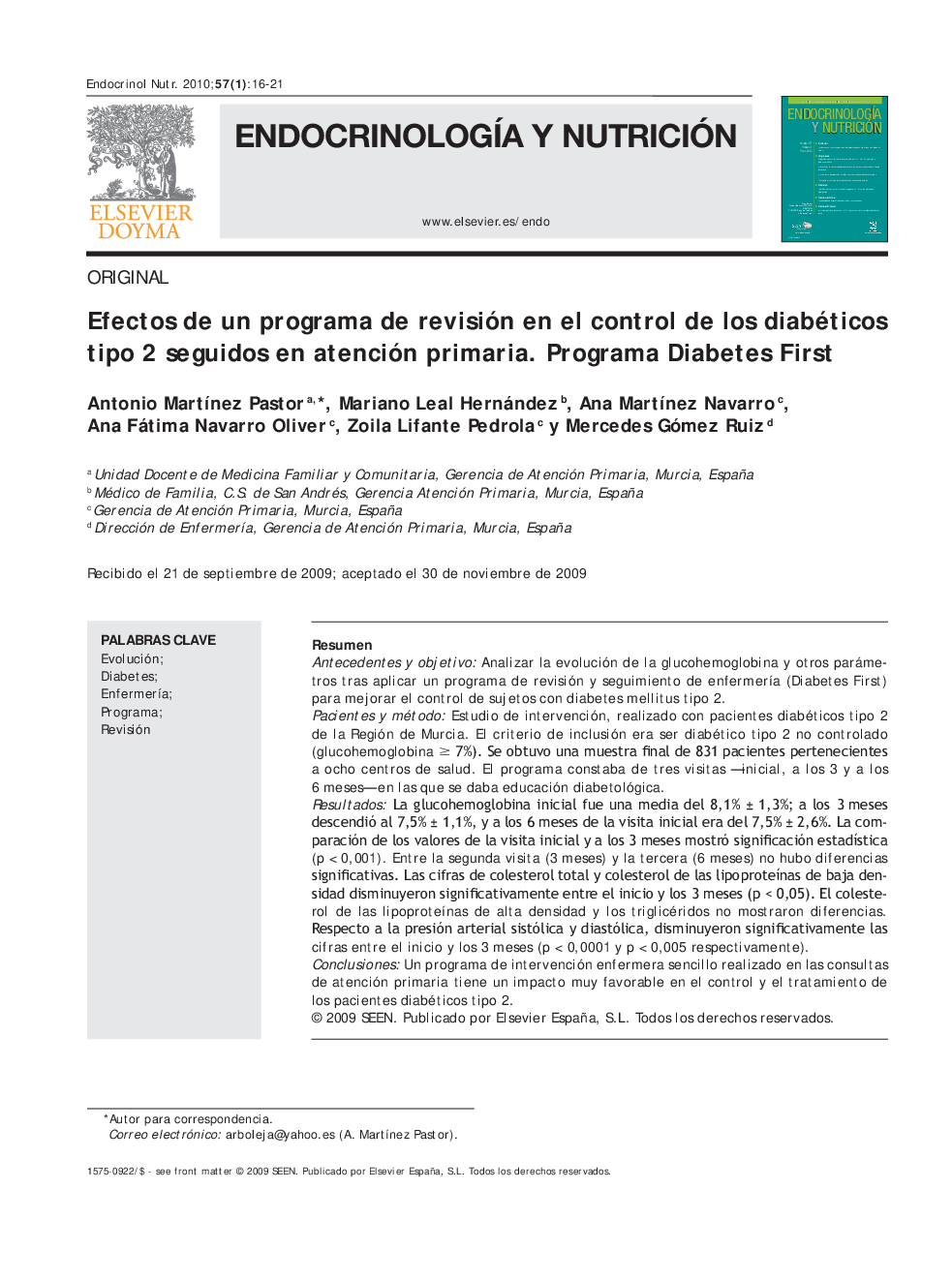| Article ID | Journal | Published Year | Pages | File Type |
|---|---|---|---|---|
| 2774061 | Endocrinología y Nutrición | 2010 | 6 Pages |
ResumenAntecedentes y objetivoAnalizar la evolución de la glucohemoglobina y otros parámetros tras aplicar un programa de revisión y seguimiento de enfermería (Diabetes First) para mejorar el control de sujetos con diabetes mellitus tipo 2.Pacientes y métodoEstudio de intervención, realizado con pacientes diabéticos tipo 2 de la Región de Murcia. El criterio de inclusión era ser diabético tipo 2 no controlado (glucohemoglobina ≥ 7%). Se obtuvo una muestra final de 831 pacientes pertenecientes a ocho centros de salud. El programa constaba de tres visitas —inicial, a los 3 y a los 6 meses— en las que se daba educación diabetológica.ResultadosLa glucohemoglobina inicial fue una media del 8,1% ± 1,3%; a los 3 meses descendió al 7,5% ± 1,1%, y a los 6 meses de la visita inicial era del 7,5% ± 2,6%. La comparación de los valores de la visita inicial y a los 3 meses mostró significación estadística (p < 0,001). Entre la segunda visita (3 meses) y la tercera (6 meses) no hubo diferencias significativas. Las cifras de colesterol total y colesterol de las lipoproteínas de baja densidad disminuyeron significativamente entre el inicio y los 3 meses (p < 0,05). El colesterol de las lipoproteínas de alta densidad y los triglicéridos no mostraron diferencias. Respecto a la presión arterial sistólica y diastólica, disminuyeron significativamente las cifras entre el inicio y los 3 meses (p < 0,0001 y p < 0,005 respectivamente).ConclusionesUn programa de intervención enfermera sencillo realizado en las consultas de atención primaria tiene un impacto muy favorable en el control y el tratamiento de los pacientes diabéticos tipo 2.
Background and objectiveTo analyze the evolution of the glycosylated hemoglobin and other parameters after performing a control program and follow-up by nurses to improve the control of the patients with type 2 diabetes mellitus (Diabetes First).Patients and methodIntervention study in type 2 diabetes mellitus patients from Murcia. The inclusion criterium was to be a type 2 diabetes mellitus patient badly controlled on diabetes parameters (glycosylated haemoglobin ≥ 7%). We included 831 patients from 8 primary care centers. The program consisted of three visits (first one, after three months and after six months), where the patients received diabetic education.ResultsThe mean initial glycosylated haemoglobin value was 8.1% ± 1.3%, after 3 months it decreased to 7.5% ± 1.1%, and after 6 months from the first visit its value was 7.5% ± 2.6%. There was a statistically significant (p < 0.001) difference between the initial glycosylated haemoglobin and the values three months later. There was not such a difference between the second and third visit. Total and low-density liporpotein cholesterol decreased significantly after 3 months (p < 0.05). High-density lipoprotein cholesterol and triglycerides showed no difference. Systolic and diastolic blood pressure significantly decreased after three months (p < 0.0001 and p < 0.005).ConclusionsA simple nursing intervention program performed in primary care centers has a very positive impact on the control and treatment of patients with type 2 diabetes mellitus.
